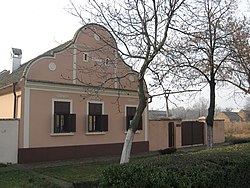Idvor
Идвор | |
|---|---|
 Mihajlo Pupin's birth house | |
| Coordinates: 45°11′12″N 20°30′31″E / 45.18667°N 20.50861°E | |
| Country | |
| Province | |
| District | South Banat |
| Municipality | |
| Elevation | 61 m (200 ft) |
| Population (2002) | |
• Idvor | 1,198 |
| Time zone | UTC+1 (CET) |
| • Summer (DST) | UTC+2 (CEST) |
| Postal code | 26207 |
| Area code | +381(0)13 |
| Car plates | PA |
Idvor (Serbian Cyrillic: Идвор) is a village in northern Serbia. It is located in the Kovačica municipality, South Banat District, Vojvodina province. The village has a Serb ethnic majority (93.98%) and its population numbers 1,198 people (2002 census).
Name
[edit]In Serbian, the village is known as Idvor (Идвор), in German as Idwor, and in Hungarian as Torontáludvar. The town's name originates from Hyd Var, which means "Guard near border crossing" in Hungarian.
Geography
[edit]Idvor is situated near the Tamiš river, 35km from Zrenjanin and 43km from Pančevo, in the Banat region of Serbia.
History
[edit]During Ottoman rule (in 1660/66), Idvor was populated by ethnic Serbs. Another wave of Serbs came to the town near the end of the 17th century during the Great Migrations, led by Arsenije III Crnojević. The Serbs arrived from Patriarchate of Peć region to serve as guardians of the Austrian military frontier against the Ottomans.[1] Until 1795 the village was situated at location known as "Staro selo", and in that year it was moved to its current position to take advantage of a more favorable terrain.[2]
The Serbian Orthodox Church in Idvor was built in 1803, with additions of clock, bells, and improvements to the tower over following decades. The iconostasis was installed in 1871 and painted by Stevan Todorović during 1876-1879.[3]
Historical population
[edit]- 1961: 1,823
- 1971: 1,621
- 1981: 1,442
- 1991: 1,308
- 2002: 1,198
Notable residents
[edit]
Serbian physicist, inventor, and philanthropist Mihajlo Pupin was born in Idvor. The Memorial Complex in Idvor is dedicated to his life and work. It consists of Mihajlo Pupin's home, the Old School (elementary school that he attended), and the National Home that he endowed to ldvor and its people, which was supposed to become a National University. The Complex gained the status of a Monument of Culture of Exceptional Importance in 1990.[4][5]
References
[edit]- ^ "From Immigrant to Inventor, by Michael Pupin—A Project Gutenberg eBook". www.gutenberg.org. Retrieved 2024-06-22.
- ^ "O NAMA". OŠ Mihajlo Pupin Idvor. Retrieved 2024-06-22.
- ^ "Идвор". Српска Православна Епархија банатска (in Serbian). Retrieved 2024-09-27.
- ^ "Музеј Пупина". www.muzejpupina.rs. Retrieved 2024-06-18.
- ^ "The Memorial Complex of Mihajlo Pupin". Завод за заштиту споменика културе у Панчеву. Retrieved 2024-06-18.
- Slobodan Ćurčić, Broj stanovnika Vojvodine, Novi Sad, 1996.
- Jovan Erdeljanović, Srbi u Banatu, Novi Sad, 1992.
- Dr. Dušan J. Popović, Srbi u Vojvodini, knjiga 1, Novi Sad, 1990.



